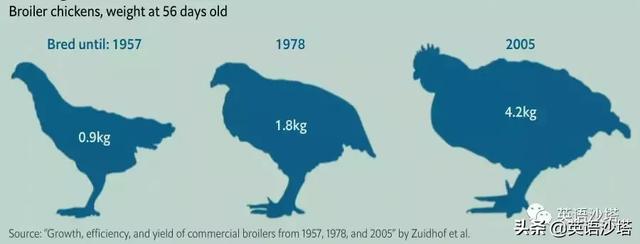
英语沙塔
本文节选自《经济学人》2019.01.19期,International版块中的一篇关于鸡肉成为最受欢迎肉类的报道。
建议大家先自主阅读原文,再学习精读笔记。本文一共五段。读完笔记后,回头再读原文段落,测试自己是否能够流畅阅读,把握文章脉络。
文末会总结此次学习写作可以使用的词句,读者也可自己总结。会定期将内容进行总结,做成word分享,希望大家也能坚持学习
1
In the 1940s America launched a series of “Chicken of Tomorrow” competitions for farmers. The aim, as described by a newspaper at the time, was to produce “one bird chunky enough for the whole family—a chicken with breast meat so thick you can carve it into steaks, with drumsticks that contain a minimum of bone buried in layers of juicy dark meat, all costing less instead of more.” The result was something along the lines of the modern broiler chicken
- launched: ~ sth 开始从事,发起,发动(尤指有组织的活动)
- a series of:一系列的
- as described by:正如 …… 所描述的
- produce:是生产、制造的意思,此处应当译作养殖
- a minimum of:最小量。I need to have a minimum of two hours to study我每天至少需要两小时来学习。
- along the lines of:类似,符合。Proposing an idea along the lines of what I'm talking about. 提出一个于我所说相符合的计划。【写作建议】与in accordance with可以替换使用
在1940年,美国为农场主发起了一系列被称为“明日之鸡”的竞赛,其目的,正如报纸当时所描述的,是为了养殖“一只足以养活一家人的大禽—一只拥有厚实胸脯肉,可以切出许多肉块的鸡,它的小腿肉多汁而少骨,却越来越便宜而不是越来越贵。”其结果与现代的肉用仔鸡相差无几。
2
Since then chickens have continued to get bigger. A study by Martin Zuidhof of the University of Alberta and colleagues documented this shift by comparing chickens that were selectively bred in 1957, 1978 and 2005. The authors found that at 56 days old the three birds had average weights of 0.9kg, 1.8kg and 4.2kg. As raising a single big bird is more efficient than raising two smaller ones, it now takes farmers just 1.3kg of grain to produce 1kg of chicken, down from 2.5kg of grain in 1985.
- documented this shift:document,记录。shift改变
- selectively:选择性地。选育selective breeding 。it is the result of selective breeding over thousands of years.这是几千年来选育的结果
- As raising a single big bird is more efficient than raising two smaller ones, it now:as引导原因状语从句,从句又是一句完整的句子,其中raising a single big bird是其主语。后面it开始写带来的结果。【写作建议】句型学习,描写因果关系时使用
- raise:这里的raise是养殖的意思,produce前面提到可以作养殖,但更偏向于生产,以及产出农产品的意思,有细微的区别。
- down from 2.5kg of grain in 1985:down,指比之前低,from,指与之前相比。【写作建议】数字表达
从那时起,鸡的体型就开始越来越大,阿尔伯塔大学的马丁·日夫科夫通过比较1957、1978和2005年选择培育的鸡的大小,记录了这些变化,作者发现,三组鸡8周龄时的平均体重分别为0.9kg、1.8kg和4.2kg。因为养殖一只体型大的鸡比饲养两只更小的鸡效率更高,现在农场主只需1.3kg谷物就可以产出1kg的鸡肉,比1985年生产1kg鸡肉少用2.5kg的谷物。

3
Farmers have also benefited from the healthy reputation of chicken. In the 1980s doctors worried that by eating too much beef and pork people were ingesting lots of saturated fat, whichwas then thought to increase the risk of heart disease. Those fears have since waned, but new evidence suggests that red meat might increase people’s chances of getting colon cancer. In contrast, poultry’s image as a healthy meat survives unscathed.
- benefited from:受益于,从……中得到好处
- the healthy reputation:直译健康的名声,这里描述的是吃鸡肉更健康的名声。另外的描述可以是we are aware of the chicken’s reputation for being healthy【地道搭配】the healthy reputation of chicken,可以替换上一句的表达。
- ingesting:~sth,吞咽,吞下
- saturated fat:饱和脂肪,能促使胆固醇增长,危害身体
- by eating……, people ……, which……:第一部分作状语,第二部分为主语描述产生的结果,第三部分非限制性定语从句进一步描述之后的结果。【写作推荐】跟第2段的句型一样,可以用于描写原因,结果,比如《闪电侠》开头片段中有这样的描述:In doing so our world was opened up to new threats,但我们的世界也因此出现了新的威胁。
- waned:月亏,也有减少的意思
- red meat:红肉,指的是牛羊肉等,未煮前是红色的肉类。
- in contrast:on the contrast,相比之下,与之相反
- image as:形象,印象。这里指鸡肉在人们心中是健康的肉类的印象。
- survives unscathed:毫发无损地存活下来
农民也从吃鸡肉健康的名声中获益。在20世纪80年代,医生们担心,通过吃大量的牛肉和猪肉,人们吞食了过多的饱和脂肪,而那时这些被认为会增加罹患心脏病的风险。如今这些担忧已经减少了,但新的证据表明红色肉类可能会增加人们患结肠癌的几率。与之相反,鸡肉作为人们印象中的健康肉类,毫发无损地存活下来。
4
It is not just fussy Western eaters who increasingly favour chicken. Rising incomes mean that demand for the meat is growing even faster in poorer countries. As a result, chickens are now the world’s most widely traded meat. In economic terms they are, in effect, the opposite of cars. They are produced whole. But their value is maximized once they are broken up.
- in economic terms:在经济方面。也可以是In terms of economics
- in effect:as a matter of fact事实上
- broken up:原形break up 分解,分开,也有分手的意思。We broke up last night我们昨晚分手了
西方人不仅仅是因为挑剔而越来越喜欢鸡肉,上升的收入意味着更贫穷的城市对肉的需求在不断提高。结果,鸡肉现在是世界上最广泛交易的肉类。从经济方面来说,事实上,鸡肉与车子正好相反。鸡肉是一整个被生产的,但他们的价值在被拆分后是最大化的。
5
Though Westerners prefer lean, white meat; many in Asia and Africa prefer dark meat, which includes legs and thighs. These preferences are reflected in local prices: in America breasts are 88% more expensive than legs; in Indonesia they are12% cheaper. Differences in the price of chicken feet are even starker. The thought of eating talons is abhorrent to many Westerners, but they often feature in Cantonese recipes. China now imports 300,000 tonnes of “phoenix claws” every year.
- are reflected in:从……反应出来
- starker:原形stark,是明显的意思,同义词有evident,obvious,distinct
- is abhorrent to:令人憎恶的,令人厌恶的 ~ to sb
- feature in:to have an important part in sth 起重要作用,占重要地位。文中指的是爪类在广东人的食谱中是重要的材料。 如Olive oil and garlic feature prominently in his recipes橄榄油和大蒜在他的食谱中占重要地位【写作推荐】take an important role in sth可以互用
- phoenix claws:凤爪
注:白肉是烹煮后呈白色的肉,如鸡胸肉;黑肉,深色肉,一般是鸡腿肉
西方人更喜欢瘦肉和白肉;而很多亚洲和非洲的人则更喜欢黑肉,包括小腿和大腿,这些偏好从当地的价格就可以反应出来。在美国,鸡胸肉比鸡肉肉贵88%,在印度尼西亚,则低了12%。鸡腿肉价格的差别则更加明显。很多西方人对于吃爪子十分厌恶,但广东人的食谱中,爪类却是重要的材料。现在,中国每年进口30万吨“凤爪”。
总结
- along the lines of:类似,符合。Proposing an idea along the lines of what I'm talking about. 提出一个于我所说相符合的计划。【写作建议】与in accordance with可以替换使用
- As raising a single big bird is more efficient than raising two smaller ones, it now:as引导原因状语从句,从句又是一句完整的句子,其中raising a single big bird是其主语。后面it开始写带来的结果。【写作建议】句型学习,描写因果关系时使用
- down from 2.5kg of grain in 1985:down,指比之前低,from,指与之前相比。【写作建议】数字表达
- the healthy reputation:直译健康的名声,这里描述的是吃鸡肉更健康的名声。另外的描述可以是we are aware of the chicken’s reputation for being healthy【地道搭配】the healthy reputation of chicken,可以替换上一句的表达。
- by eating……, people ……, which……:第一部分作状语,第二部分为主语描述产生的结果,第三部分非限制性定语从句进一步描述之后的结果。【写作推荐】跟第2段的句型一样,可以用于描写原因,结果
- feature in:to have an important part in sth 起重要作用,占重要地位。文中指的是爪类在广东人的食谱中是重要的材料。 如Olive oil and garlic feature prominently in his recipes橄榄油和大蒜在他的食谱中占重要地位【写作推荐】take an important role in sth可以互用





